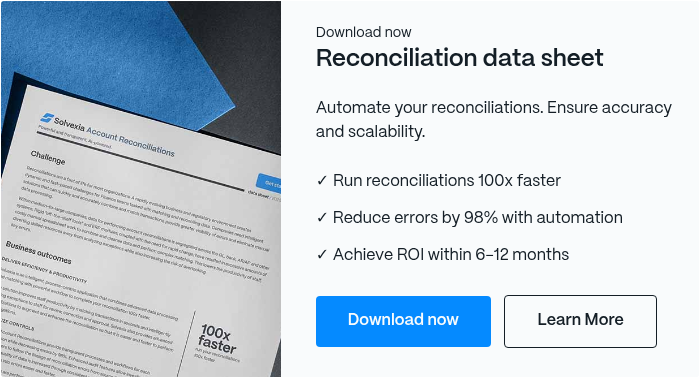Internal Control Bank Reconciliation: A Guide for Enhanced Financial Management

Bank reconciliation is more than just matching numbers—it's a critical control mechanism that safeguards financial accuracy and prevents fraud. Yet many organizations still rely on manual reconciliation processes, leaving them vulnerable to errors while consuming excessive time and resources.
This guide shows how internal controls and automation transform bank reconciliation from a routine task into a powerful financial management tool. From essential principles to practical implementation, we'll examine:
- Essential components of bank reconciliation
- Key internal control principles
- Best practices for implementation
- Benefits of automation
- Steps to modernize your process
Whether you manage a small finance team or oversee complex banking operations, these insights will help you build stronger financial controls while improving reconciliation efficiency.
Coming Up
What is Bank Reconciliation?
Bank reconciliation is the systematic process of comparing an organization’s internal financial records against the statements provided by their bank account. This critical financial procedure ensures that both sets of records match and accurately reflect all transactions, balances, and financial activity.
Bank records play a crucial role in verifying the accuracy of financial data, helping to identify discrepancies such as outstanding deposits and bank errors.
At its core, bank reconciliation serves as a fundamental financial control mechanism by:
- Verifying that all transactions are properly recorded
- Ensuring the accuracy of both bank and book balances
- Identifying any unauthorized or fraudulent activities
- Maintaining precise cash flow management
Regular monthly reconciliations are essential for maintaining financial accuracy and detecting discrepancies early. This timing is crucial because the sooner disparities are identified, the easier they are to investigate and resolve.
Common discrepancies that bank reconciliation helps identify include:
- Deposits in Transit: Funds that have been recorded in your books but haven’t yet cleared the bank
- Outstanding Checks: Checks that have been issued but haven’t been cashed by the recipient
- Bank Fees: Service charges or fees that may not be automatically recorded in your internal records
- Electronic Transactions: Direct deposits or automatic payments that might not be immediately captured in internal records
- Coding Errors: Mistakes in recording transactions or categorizing expenses
- Cash Receipts: Cash recorded by the company that has not yet appeared on the bank statement, leading to outstanding deposits
Understanding these common disparities is crucial for effective reconciliation, as they often explain the majority of differences between bank and book balances. By systematically reviewing and addressing these items, organizations can maintain accurate financial records and strengthen their overall financial control framework.
Understanding the Bank Reconciliation Process
The bank reconciliation process is a critical internal control that ensures the accuracy and integrity of a company’s financial records. It involves comparing the company’s bank statement with its internal accounting records to identify any discrepancies or differences. This process is typically performed on a regular basis, such as monthly, to ensure that the company’s cash and bank accounts are accurately reflected in its financial statements.
The bank reconciliation process involves several key steps:
- Obtaining the Bank Statement and Internal Accounting Records
- Identifying and Recording Unrecorded Transactions
- Reconciling the Bank Statement Balance
- Investigating Discrepancies
- Making Necessary Adjustments
By following these steps, organizations can maintain accurate financial records, which is essential for making informed business decisions and ensuring financial integrity.
The Role of Internal Control in Bank Reconciliation
Bank reconciliation serves as a crucial detective control within an organization's financial framework, acting as a systematic safeguard against errors, discrepancies, and potential fraudulent activities. When properly integrated with robust internal controls, the reconciliation process becomes a powerful tool for maintaining financial integrity.
Detective Control Functions
The detective nature of bank reconciliation manifests in several critical ways:
- Identifying unauthorized transactions or suspicious patterns
- Catching data entry errors or system glitches
- Detecting timing differences that could impact financial reporting
- Uncovering potential internal fraud or external theft attempts
- Ensuring compliance with accounting policies and procedures
Segregation of Duties
One of the most crucial internal control elements in bank reconciliation is the segregation of duties. This principle requires that different individuals handle various aspects of the reconciliation process to minimize risk and prevent fraudulent activities.
Key segregation points include:
- Transaction Recording: The person recording daily transactions should be different from the one performing reconciliations
- Reconciliation Performance: The individual conducting the reconciliation should not have check-signing authority
- Review Process: A separate person should review and approve completed reconciliations
- System Access: Different levels of system access should be assigned based on role responsibilities
Oversight and Review Procedures
Effective oversight strengthens the reconciliation process through:
Secondary Reviews
- Independent verification of reconciliation accuracy
- Assessment of supporting documentation
- Evaluation of unusual items or discrepancies
- Confirmation that all differences are properly explained and resolved
Approval Protocols
- Formal sign-off requirements for completed reconciliations
- Documentation of review findings
- Escalation procedures for significant discrepancies
- Regular reporting to management on reconciliation status
Monitoring Activities
- Tracking of reconciliation completion timelines
- Documentation of outstanding items
- Regular assessment of control effectiveness
- Periodic review of the entire reconciliation process
By implementing these internal control measures, organizations create a robust framework that not only detects issues but also prevents potential problems before they can impact financial accuracy and security.
Solvexia's automated reconciliation platform enhances these controls by providing audit trails, enforcing segregation of duties through role-based access, and delivering real-time monitoring dashboards that help organizations maintain compliance while reducing the risk of fraud and error.
Reconciling the Bank Statement
Reconciling the bank statement is a critical step in the bank reconciliation process. It involves comparing the bank statement balance with the internal accounting records to identify any discrepancies or differences. The process typically involves the following steps:
- Obtaining the Bank Statement and Internal Accounting Records: Gather the bank statement and the corresponding internal accounting records for the reconciliation period.
- Identifying and Recording Unrecorded Transactions: Identify any transactions on the bank statement that have not yet been recorded in the internal accounting records, such as bank fees, bank interest, or direct debits.
- Reconciling the Bank Statement Balance: Compare the bank statement balance with the internal accounting records, adjusting for any unrecorded transactions.
- Investigating Discrepancies: Identify and investigate any discrepancies or differences between the bank statement and the internal records.
- Making Necessary Adjustments: Adjust the internal accounting records to reflect any corrections or updates needed to match the bank statement.
This reconciliation process helps ensure that the company’s cash and bank accounts are accurately reflected in its financial statements. It also helps to identify any errors or discrepancies that may have occurred during the accounting period, ensuring the integrity of financial reporting.
Managing Cash and Bank Reconciliation
Managing cash and bank reconciliation is a critical aspect of a company’s financial management. It involves ensuring that the company’s cash and bank accounts are accurately reflected in its financial statements, and that any discrepancies or differences are identified and investigated.
Effective cash and bank reconciliation management involves several key steps:
- Implementing a Robust Internal Control System: Establish a strong internal control system to ensure accurate financial records and prevent fraud.
- Regularly Reconciling the Bank Statement: Perform regular reconciliations of the bank statement with internal accounting records to maintain accuracy.
- Identifying and Investigating Discrepancies: Promptly identify and investigate any discrepancies or differences between the bank statement and internal records.
- Making Necessary Adjustments: Adjust the internal accounting records to correct any discrepancies and ensure they match the bank statement.
- Maintaining Accurate Financial Records: Keep financial records accurate and up-to-date to support informed business decisions and financial reporting.
By implementing these steps, companies can ensure that their financial records are reliable and that they are able to make informed business decisions based on accurate data.
Common Challenges in Bank Reconciliation
Bank reconciliation can be a complex and time-consuming process, and companies may face several challenges when performing bank reconciliations. Some common challenges include:
- Identifying and Investigating Discrepancies: Discrepancies between the bank statement and internal accounting records can be difficult to identify and investigate, especially if there are many transactions.
- Ensuring Accurate Transaction Recording: Ensuring that all transactions are accurately recorded and reflected in the financial statements can be challenging, particularly for high-volume accounts.
- Managing Multiple Bank Accounts: Companies with multiple bank accounts and statements may find it difficult to manage and reconcile all accounts accurately.
- Dealing with Bank Fees and Charges: Bank fees and charges that are not automatically recorded in internal records can create discrepancies that need to be identified and adjusted.
- Regular Reconciliation: Ensuring that the bank reconciliation process is performed on a regular basis can be challenging, especially for organizations with limited resources.
Best Practices for Bank Reconciliation with Internal Controls
Implementing robust internal controls within the bank reconciliation process requires a structured approach combining timely execution, modern technology, and comprehensive documentation. Here's how organizations can optimize their reconciliation processes while maintaining strong controls.
1. Regular Monthly Reconciliations
Consistent monthly reconciliations are fundamental to maintaining financial accuracy and control. This practice offers several key advantages:
- Early detection of discrepancies when they're easier to resolve
- Improved cash flow management and forecasting
- Reduced risk of fraud through regular monitoring
- Better compliance with accounting standards and regulations
- More accurate financial reporting for stakeholder decision-making
2. Leveraging Automation for Enhanced Control
Modern automation solutions, such as Solvexia, transform traditional reconciliation processes by introducing powerful control mechanisms:
Error Reduction
- Elimination of manual data entry mistakes
- Consistent application of reconciliation rules
- Automated matching of transactions
- Real-time verification of calculations
Control Enhancement
- Built-in segregation of duties through user roles
- Automated audit trails of all activities
- Systematic flagging of unusual items
- Standardized reconciliation workflows
Efficiency Gains
- Reduced processing time for high-volume transactions
- Automatic identification of matching items
- Real-time dashboards for monitoring progress
- Immediate escalation of discrepancies
3. Documentation and Audit Support
Maintaining comprehensive documentation is crucial for both compliance and audit purposes:
Required Documentation
- Reconciliation worksheets showing all calculations
- Supporting documents for reconciling items
- Evidence of review and approval
- Resolution notes for identified discrepancies
- System-generated reports and analysis
Best Practices for Documentation
- Store documents in a centralized, secure location
- Maintain consistent naming conventions
- Include clear explanations for adjustments
- Document the resolution of reconciling items
- Keep records according to retention policies
Audit Trail Maintenance
- Record who performed each reconciliation
- Track when reviews and approvals occurred
- Document any process exceptions
- Maintain history of system-generated reports
- Store evidence of control effectiveness
4. Implementation Timeline
To optimize your reconciliation process:
Daily Tasks
- Review bank activity for unusual items
- Process incoming transactions
- Update internal records
Monthly Tasks
- Complete full bank reconciliation
- Obtain necessary approvals
- Clear outstanding items
- Generate required reports
Quarterly Reviews
- Assess control effectiveness
- Update procedures as needed
- Review user access rights
- Evaluate automation efficiency
By following these best practices and leveraging automation tools like Solvexia, organizations can create a more efficient, accurate, and controlled reconciliation process while maintaining strong internal controls and audit readiness.
Key Benefits of Implementing Automated Controls
Integrating automated controls into the bank reconciliation process transforms traditional manual procedures into a streamlined, secure, and highly efficient operation. Here's a detailed look at the key advantages organizations gain through automation.
Enhanced Accuracy Through Automation
Automated reconciliation systems significantly reduce the risk of errors that commonly plague manual processes:
Error Prevention
- Elimination of manual data entry mistakes
- Consistent application of reconciliation rules
- Standardized calculation methods
- Automatic validation checks
Real-Time Accuracy
- Immediate identification of discrepancies
- Automated matching of transactions
- Systematic balance verification
- Continuous data integrity checks
Advanced Fraud Prevention and Detection
Modern automated controls provide robust fraud prevention capabilities through:
Continuous Monitoring
- Real-time transaction surveillance
- Pattern recognition for suspicious activities
- Immediate flagging of unusual transactions
- Automated alerts for threshold violations
Early Warning Systems
- Detection of unauthorized transactions
- Identification of irregular patterns
- Monitoring of user activities
- Tracking of system access attempts
Audit-Ready Documentation and Reporting
Automated systems create comprehensive audit trails and documentation that streamline the audit process:
Systematic Record-Keeping
- Complete transaction histories
- Detailed reconciliation logs
- User activity tracking
- Time-stamped approvals and reviews
Enhanced Reporting Capabilities
- Customizable audit reports
- On-demand access to historical data
- Detailed exception reports
- Comprehensive compliance documentation
Measurable Business Impact
The implementation of automated controls delivers quantifiable benefits:
Time Savings
- Reduced processing time
- Faster reconciliation completion
- Quick discrepancy resolution
- Streamlined approval processes
Cost Reduction
- Lower operational costs
- Reduced audit preparation time
- Minimized error correction expenses
- Decreased staffing requirements
Risk Mitigation
- Enhanced fraud protection
- Improved regulatory compliance
- Reduced human error risk
- Better control environment
Compliance and Governance Benefits
Automated controls strengthen organizational governance through:
Regulatory Compliance
- Consistent control application
- Documented procedures
- Traceable transactions
- Regular compliance checking
Policy Enforcement
- Automated rule application
- Standardized processes
- Controlled access rights
- Systematic policy updates
By implementing automated controls, organizations can achieve higher accuracy, stronger fraud prevention, and more efficient audit processes while reducing operational costs and strengthening their overall control environment.
Conclusion and Next Steps
The integration of internal controls with bank reconciliation processes is essential for maintaining financial accuracy and security. Through this guide, we've seen how proper controls, especially when automated, create a robust framework for financial management.
Key Takeaways
- Regular reconciliations prevent financial discrepancies
- Segregation of duties reduces fraud risk
- Automated controls enhance accuracy and efficiency
- Systematic documentation ensures audit readiness
Moving Forward
Traditional manual reconciliation processes struggle to meet today's complex financial demands. Modern solutions like Solvexia offer:
- Automated matching and verification
- Built-in control frameworks
- Real-time monitoring
- Comprehensive audit trails
Ready to transform your bank reconciliation process? Request a demo today to learn how our automation solution can strengthen your financial controls while saving time and resources.
FAQ
Intelligent reconciliation solution
Intelligent rebate management solution
Intelligent financial automation solution
Intelligent Financial Automation Solution
Intelligent financial automation solution
Intelligent financial automation solution
Intelligent financial automation solution
Intelligent financial automation solution
Intelligent regulatory reporting solution
Free up time and reduce errors
Recommended for you

Request a Demo
Book a 30-minute call to see how our intelligent software can give you more insights and control over your data and reporting.

Reconciliation Data Sheet
Download our data sheet to learn how to automate your reconciliations for increased accuracy, speed and control.

Regulatory Reporting Data Sheet
Download our data sheet to learn how you can prepare, validate and submit regulatory returns 10x faster with automation.

Financial Automation Data Sheet
Download our data sheet to learn how you can run your processes up to 100x faster and with 98% fewer errors.

Financial Automation Data Sheet
Download our data sheet to learn how you can run your processes up to 100x faster and with 98% fewer errors.

Financial Automation Data Sheet
Download our data sheet to learn how you can run your processes up to 100x faster and with 98% fewer errors.

Financial Automation Data Sheet
Download our data sheet to learn how you can run your processes up to 100x faster and with 98% fewer errors.

Financial Automation Data Sheet
Download our data sheet to learn how you can run your processes up to 100x faster and with 98% fewer errors.

Financial Automation Data Sheet
Download our data sheet to learn how you can run your processes up to 100x faster and with 98% fewer errors.

Rebate Management Data Sheet
Download our data sheet to learn how you can manage complex vendor and customer rebates and commission reporting at scale.

Top 10 Automation Challenges for CFOs
Learn how you can avoid and overcome the biggest challenges facing CFOs who want to automate.
.svg)








